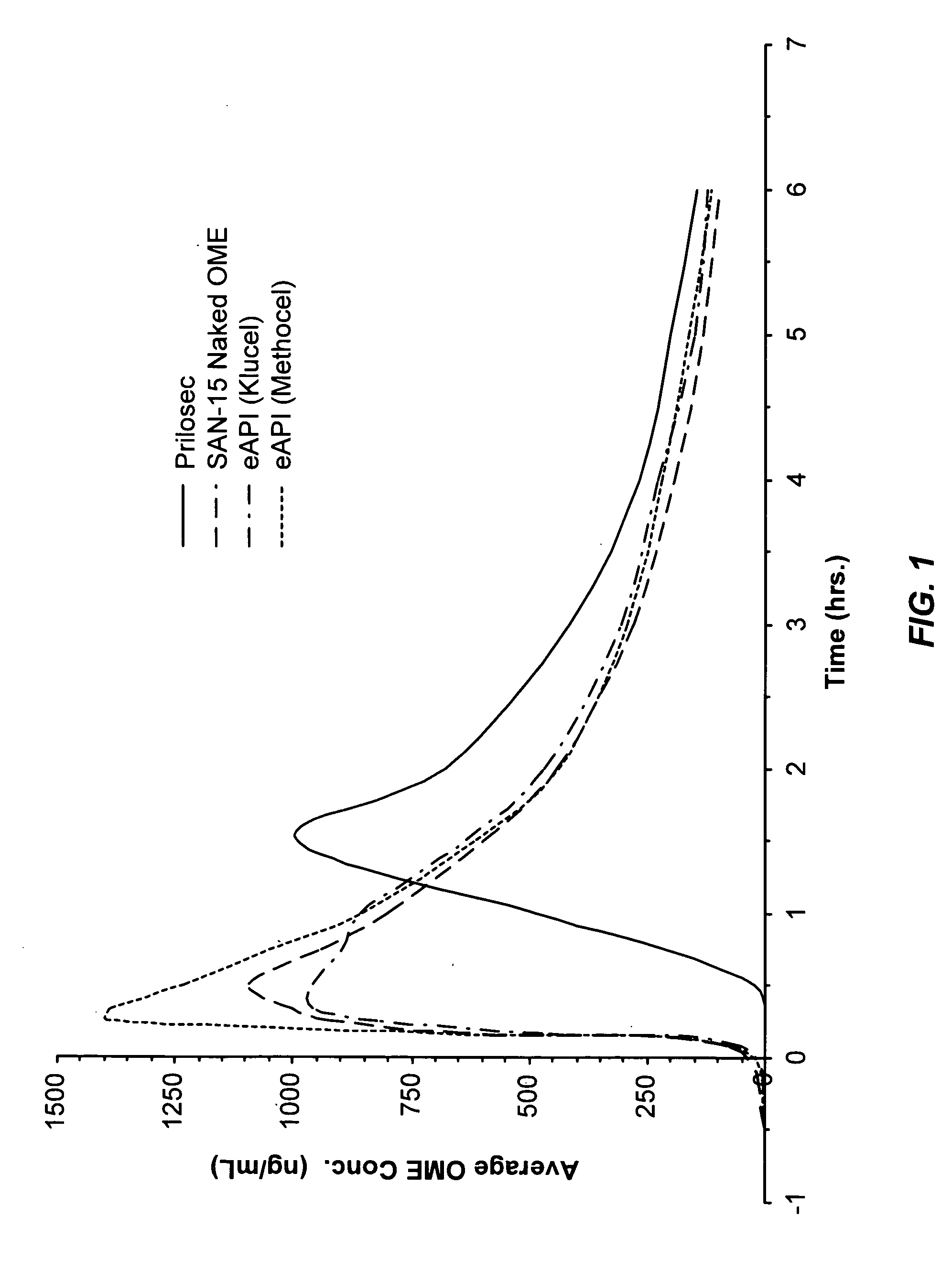Pharmaceutical formulatins useful for inhibiting acid secretion and methods for making and using them
a technology of formulatins and pharmaceutical formulations, applied in the field of pharmaceutical formulations, can solve the problems of drug exposure to gastrointestinal acid in the stomach, drug resistance to acid degradation, and rapid destruction, and achieve the effect of enhancing the shelf life and prolonging the shelf life of the pharmaceutical formulation
- Summary
- Abstract
- Description
- Claims
- Application Information
AI Technical Summary
Benefits of technology
Problems solved by technology
Method used
Image
Examples
example 1
Microencapsulation Materials and Methods
[0204] Microencapsulation Process Using Spinning Disk Atomization
[0205] The basic operation for the spinning disk process used was as follows: An encapsulation solution was prepared by dissolving the encapsulation material in the appropriate solvent. Omeprazole was dispersed in the coating solution and fed onto the center of the spinning disk. A thin film was produced across the surface of the disk and atomization occurs as the coating material left the periphery of the disk. The microspheres were formed by removal of the solvent using heated airflow inside the atomization chamber and collected as a free-flowing powder using a cyclone separator.
[0206] Spray Drying Microencapsulation Process
[0207] A spray dryer consisted of the same components as a spinning disk except atomization by a high pressure nozzle or two-fluid nozzle instead of a spinning disk can be also used.
[0208] A spray dryer with attached fluid-bed dryer for sizing of dried ...
example 2
Preparation of Chewable Tablets
[0210] The chart below summarizes the wt %, the feed rates used, and the inlet / outlet temperatures for eleven different omeprazole microspheres.
[0211] The tablets were manufactured using the following materials: Encapsulated omeprazole (varied based on payload, to deliver 40 mg potency), sodium bicarbonate (1260 mg), calcium carbonate (790 mg), croscarmellose sodium (64 mg), Klucel (160 mg), Xylitab 100 (380 mg), microcrystalline cellulose (128 mg), sucralose (162 mg), peppermint durarome (34 mg), peach flavor (100 mg), masking powder (60 mg), FD&C Lake No. 40 Red (3 mg), and magnesium stearate (32 mg).
[0212] The amount of encapsulated omeprazole used in each tablet batch varies based on the actual payload of each set of microcapsules to achieve the theoretical dose of 40 mg. The omeprazole was microencapsulated in a similar manner as that described in Example 1. All ingredients are mixed well to achieve a homogenious blend.
[0213] Tablets containin...
example 3
Preparation of Chewable Tablets
[0215] Various tablets were manufactured using the following materials: Encapsulated omeprazole (varied based on payload, to deliver 40 mg potency), sodium bicarbonate (600 mg), MS-95 (5% starch) (737 mg), croscarmellose sodium (33 mg), Klucel (90 mg), Xylitab 100 (200 mg), sucralose (80 mg), peppermint durarome (10 mg), peach flavor (52 mg), masking powder (27 mg), Lake FD & C Red #40 (2 mg), and magnesium stearate (17 mg).
PUM
| Property | Measurement | Unit |
|---|---|---|
| concentration | aaaaa | aaaaa |
| concentration | aaaaa | aaaaa |
| diameter | aaaaa | aaaaa |
Abstract
Description
Claims
Application Information
 Login to View More
Login to View More - R&D
- Intellectual Property
- Life Sciences
- Materials
- Tech Scout
- Unparalleled Data Quality
- Higher Quality Content
- 60% Fewer Hallucinations
Browse by: Latest US Patents, China's latest patents, Technical Efficacy Thesaurus, Application Domain, Technology Topic, Popular Technical Reports.
© 2025 PatSnap. All rights reserved.Legal|Privacy policy|Modern Slavery Act Transparency Statement|Sitemap|About US| Contact US: help@patsnap.com


